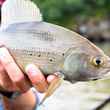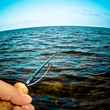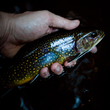Spring runoff hasn’t muddied all of the water yet so I can clearly see where I’m placing my foot in the freestone river. Pebbles and a smudge of silt swirl around my wading boots turning the new, white-felt sole into a sponge absorbing green hues and gunk. I take another step. The sole on my other foot is designed dark so it doesn’t change color. It doesn’t grab as well either. It’s rubber. Rubber is on my right foot. Felt is on my left. I’m wading in mismatched boots testing the grip ability of rubber versus felt. Grip is where angler arguments start, but the backstory on boot bottoms and where that puts anglers today has even more grab.
“Felt was first in popularity,” says Josh Prestin, Redington brand manager. “ Rubber gained popularity in 2008 to 2010 because of invasive species talk. Before that, felt was the way to go and time, energy and thought wasn’t put into rubber.”
Now time, energy, thought and money are put into rubber, but its biggest drawback is still lack of grip. Felt ran the river until 2008 because it sticks well in slick conditions like wet rocks covered in moss. It was the standard by which all anglers stayed afloat, then invasive species invaded waterways and rubber started sliding into rivers.
Idaho tried to ban felt-soled wading boots in 2011 because of the sole’s potential to host and transfer invasive species to other watersheds. It didn’t fly in the Gem State, but it did in Maryland, the first state to ban felt. That was in 2011. Six other states followed: Alaska, Missouri, Nebraska, Rhode Island, South Dakota and Vermont. Vermont reversed its ban in summer 2016. The rest of the bans are still in effect with Yellowstone National Park considering a jump on the ban bandwagon in 2018.
Hatch Magazine reported on a section of the Yellowstone River in Montana that closed last summer after a whitefish die-off due to Proliferative Kidney Disease (PKD). The disease didn’t go belly up in Yellowstone, but that’s the straw that broke the camel’s back. Banning felt would be considered part of the park’s effort to combat aquatic invasive species.
“We wouldn’t want to ban a boot style if there wasn’t an alternative, but now there are alternatives,” says Todd Koel, Yellowstone National Park native fish conservation program leader. “That’s why, as a part of bolstering our overall aquatic invasive species prevention in Yellowstone, the park will probably be going to a ban on felt soles in 2018.”
Because felt grips and rubber slips, the theory is rubber grabs less invasives, but angler stability is compromised. To counter that, the fishing industry started producing cleats, spikes and screws. Rubber started sticking, and selling, better.
“It took me a while to warm up to it, but now I like rubber better than felt,” says Jimmy Gabettas, Jimmy’s All Seasons Angler owner. “Especially Vibram rubber soles. When you step out of water onto mud or grass, it’s better than felt and snow doesn’t build up on rubber like felt.”
Two hours west of Jimmy’s is Silver Creek where anglers must soak their boots in soapy tubs before and after fishing. The creek already has invasive New Zealand mud snails in it, but they’re not spreading. Boot baths may help with containment.
“Protection, that is my biggest mission,” says Sunny Healey, Silver Creek Preserve manager. “And anglers don’t mind at all. Soaking stations for boots are just like sinks for washing your hands to get debris off, but this is for mussels and snails.”
Gabettas sells rubber and felt in his Idaho Falls, Idaho fly shop, but outfitter John Huber of Picabo Angler near Silver Creek doesn’t give customers a choice. He stopped selling felt soles in 2014. He sells rubber only and he’s eager to explain why when customers question him.
“Better safe than sorry,” Huber says. “Our living is dependent on the health of our ecosystem. Why put that at risk if you can prevent with something as simple as switching the soles of your boot?”
Invasives are the reason for rubberizing a fishing trip, but the debate isn’t as simple as changing soles. Soles attach to boots. Boots wrap around waders. Waders have gravel guards. All of those layers are good places to hide bad stuff. The invasive argument goes further soles and anglers, and the states they fish in, are realizing that. That’s why the list of states banning felt isn’t getting longer. If the rubber versus felt debate did anything in the name of water, it raised awareness for properly cleaning your equipment, boots soles and beyond.
“Take responsibility and clean your gear,” Prestin says. “If you care for your stuff in an appropriate way, you’re not going to have a negative impact on the places you fish.”






























Comments
Paul replied on Permalink
Not looking to debate the merits of felt vs rubber with regards to invasives, but try stepping on grass with felt, dry grass is the worst. It is like walking on glare ice! No hyperbole. The soles of my boots were pointed skyward! Not cool. Felt isn't the panacea when it comes traction.
C Nieb replied on Permalink
I will not go back to felt. Rubber on the banks is much safer than felt. I've fallen too many times on the bank, broke rods, cut hand, hurt body, to make felt attractive.
Don't even try to wade with snow on the banks with felt. The wet felts pick up snow like platform shoes and the first step into water will give you a very cold fall.
Anonymous replied on Permalink
But but but! ... I'm an older fly fisherman who needs all the grip he can get when wading ... I tried "StreamTred" and Vibram rubber soles, and it was like wading on greased glass ... I wear Korkers (I'm a huge fan) and use the Vibram rubber soles on the hike to the water's edge, and then I change to felt soles or if the wading is particularly difficult, to the Alumatrax soles ... when I'm drifting a river in my WaterStrider or NFO Predator, I wear the studded felt soles but carry the Alumatrax just in case ... when I'm fishing from an inflatable on a lake, I wear the Vibram rubber soles ...
Brian Chaney replied on Permalink
As someone who has spent a lot of time researching this topic, I have been disapointed in the way the media has covered the topic generally over the years. Portrayals of felt being the cause of invasive species that lead to conclusions like "Why put that at risk if you can prevent with something as simple as switching the soles of your boot?" in my opinion are misguided. New Zealand was the first to ban felt, they did so after lots of research that concluded more invasive species/organisms could possibly be transferred inside of a boot than on a felt sole (their 90+ page research is available online for those who are interested). They couldn't ban boots, so they chose to target felt because it takes longer than other boot materials to dry (& the US states began to follow this lead). Cleaning and drying all your gear is the key message that we should be promoting as an industry, not rubber or felt. At Korkers, we have moved away from leather (due to long dry times), created sole interchangeability (allowing for sole customization & easier drying methods), & developed new quick drying sole materials such as Svelte to help address this topic which have unfortunately been stifled by many states (and banned) since they are not "rubber". Let's talk start talking about the real issue, clean and dry times (vs. felt or rubber)....that will lead to better education among anglers, safer wading for anglers, & push manufacturers to develop new innovations & new materials that help alleviate these issues. Rubber Soles (including Vibram) may work on Silver Creek or on other small freestone rivers, but I can tell you from firsthand experience both from my own wading/testing and from other manufacturers reporting wading injuries to me in confidence that it isn't a safe choice on many of the North American river systems (Deschutes, Umpqua, Bulkley, Salmon River are a few that quickly come to mind). I am all for protecting our fisheries & taking protective measures to reduce the chances of damaging the environment, but also believe that if anglers are educated & truly understand our issues (cause & effect), we will be better off & will see new breakthroughs in technology & equipment that will allow anglers to wade safely & have a minimal impact on the environment.
Darren replied on Permalink
Good points. What about the guy who is so worried about his boot soles spreading disease, yet he rolls in with a Bigfoot diesel truck blasting black smoke into the boat launch with wannabe fisherman stickers all over his back window? He'll tell you why you shouldn't wear felt but loves to rev the engine.
Darren replied on Permalink
This actually happened to me recently. I was really shocked. I wonder if he recycles?
Bruce Runion replied on Permalink
I've been using vibrem rubber sole almost 12 years and find if you clean them and use baking soda after bleaching they get their tackiness back plus you don't fall when you hit a muddy bank or wet leaves and grass saving you sprained ankles and broken wrist as wearing felt soles, but as you stated was your boots and even your waders if your going to new water especially. I live in Missouri and when they banned rubber soles lots of people complained but don't here it quite as much now, just figured DOC need enough testing before mandating
R Weiss replied on Permalink
How about a list of effective detergents/biocides to wash our equipment with at home/on an individual basis? In all the articles I have read, this information seems the most difficult to find.
Anonymous replied on Permalink
What about brands like Korkers that come with interchangeable soles? Even if you only use the rubber soles, they have gaps between the sole and the shoe bottom for critters to hide. Are they also going to ban certain brands?
Fred replied on Permalink
In Nevada we have a choice, I have never had any dedicated wading boots. I have had the luxury of using old worn out nylon upper shoes. I can say this, rubber soles are a travesty looking for a place to happen. I have been eyeing a hybred sole felt with studs for this river system I fish on. Carson and South Carson rivers. I also plan on fishing the Truckee river as well. I am not convinced either Felt or Rubber is a "silver bullet" for traction in all circumstances. that is why I have been seeing these part Felt/part rubber soles with carbide steel spikes or studs in magazines and stores. I think that this might be a better idea. this is just my 2 cents worth.
Dataminer replied on Permalink
Most of you are unaware that in the proposed and passed legislation that I have been able to find, there is an exemption for state and federal employees.
This allows fisheries as well as other personnel to use felt soled waders and boots. It seems to me that if this is important, those who are routinely in the waters and are more likely to be in different watersheds routinely, should be the first to transition to rubber soles. Instead the state exempts their own people while mandating a change for their population.
Notice the nearly identical language in legislation in Montana and Vermont. Montana's is stalled in committee and Vermont's has passed. If the ban is based on science, should it not apply to everyone? This is the kind of legislation that burdens the public, but exempts government which drives me nuts.
In Montana:
"NEW SECTION.**Section 2.**Use of felt-soled boots and waders prohibited.
(1) A person may not use external felt-soled boots or external felt-soled waders in the waters of the state.
(2) The possession of external felt-soled boots or external felt-soled waders on the banks or shores of a stream or lake or in a boat, raft, canoe, or other water vessel is prima facie evidence that the person or persons in whose possession the boots or waders are found were using the boots or waders in the waters of the state.
(3) The provisions of this section do not apply to a state or federal employee or emergency personnel, including fire, law enforcement, and emergency medical technicians, using external felt-soled boots or external felt-soled waders when acting within the scope of duty."
In Vermont:
"Sec. 1. 10 V.S.A. § 4616 is added to read: § 4616. FELT-SOLED BOOTS AND WADERS; USE PROHIBITED
It is unlawful to use external felt-soled boots or external felt-soled waders in the waters of Vermont, except that a state or federal employee or emergency personnel, including fire, law enforcement, and EMT personnel, may use external felt-soled boots or external felt-soled waders in the discharge of official duties."
So the ultimate irony is that a warden can give you a citation for wearing felt boots while wearing felt boots himself. How crazy is that?
Dataminer replied on Permalink
Since no HTML tags are allows, you can search on Google for the source references in my post
Dydimo is not an invasive in North American but it is to New Zealand. Theffore New Zealand can serve as a testing laboratory to see if (1) restriction to rubber soled wading boots plus (20 decontamination will work.
The most aggressive policies against Dydimo using methods 1 and 2 have not worked in New Zealand, which has the best monitoring system for invasive spread.
New Zealand has the most rigid laws (The fine for spreading Dydimo is 5 years in Prison and/or a $100,000.00 fine) to prevent dydimo spread and yet it continues to spread. Dydimo has spread to other areas in every year since it was discovered in 2004 and restrictions were placed in 2005.
Unfortunately, Didymo continues to spread in New Zealand. See: Didymo confirmed in Waimakariri River | MAF Biosecurity New Zealand
""The find is very disappointing and significant as the Waimakariri is a popular river for many recreational activities in the region."
Didymo Found In Three More Tasman Rivers and
Didymo found in three more Tasman rivers: Media release 6 May 2010:
"Didymo has been found in three more Nelson-Tasman rivers this year but there have been no new finds of the pest algae in Marlborough and Kaikoura waterways."
Didymo found in the Upper Rangitata: Media release 16 October 2009:
"Routine testing of high conservation value freshwater sites has found didymo in the Upper Rangitata River.
This find has disappointed Department of Conservation (DOC), Fish and Game and the local community.
Despite there being infestations close by in the Rangitata Gorge, these upper sites had tested negative since regular didymo testing began two years ago.
The Peel Forest and Rangitata gorge community have put a huge effort into preventing didymo from spreading into these areas so far."
If it can't work there, what is is the likelyhood it can work here? The inconvenient truth is that rubber soles will delay, but not prevent the spread of invasives in the more heavily used rivers of the USA. Because of the heavier use, I would expect a faster spread even with rubber soles.
Search Wikipedia for "Didymo in New Zealand
Even the New Zealand Biosecurity Agency says that there is no way to stop Dydimo or eradicate Dydimo:
"Can I receive a fine if I spread didymo?
Didymo has been declared to be an Unwanted Organism under the Biosecurity Act 1993. It is an offence to knowingly spread an Unwanted Organism with [b]penalties of up to 5 years imprisonment, and/ or a fine of up to $100,000.
Will didymo continue to spread to rivers throughout New Zealand?
Yes. Didymo will likely continue to spread to unaffected areas within New Zealand. Research on the environmental variables which control didymo's growth (water depth and flow rate, nutrients, light, invertebrate grazing, etc.) has helped identify which habitats and locations it is most likely to establish. Ongoing passive and active surveillance will help determine rate and range of spread.* Human activities are considered the most likely source of spread of didymo between rivers and catchments."
Can didymo be eradicated in New Zealand?
No. Eradicating any microscopic organism from a natural environment is virtually impossible, especially in an aquatic environment.[/b] We know of no systematic attempts to eradicate invasive blooms of didymo. This is likely because of its widespread distribution and because in a number of countries it is considered a native species.
While we work to understand more about the physical, chemical and biological factors which control didymo, our efforts will continue to be focused on reducing the spread from known affected river systems."
These are FAQs related to Didymo by the NZ government agency MAF Biosecurity New Zealand
Kent replied on Permalink
I've had great secure footing with strap on Hillsound microcleats. Are easy to take off if you're drift boat hopping to fast water or climbing over boulders/lava flows in fast water. Rinse and dry when done.
Pages